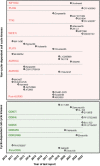Seize the engine: Emerging cell cycle targets in breast cancer
- PMID: 38264947
- PMCID: PMC10807317
- DOI: 10.1002/ctm2.1544
Seize the engine: Emerging cell cycle targets in breast cancer
Abstract
Breast cancer arises from a series of molecular alterations that disrupt cell cycle checkpoints, leading to aberrant cell proliferation and genomic instability. Targeted pharmacological inhibition of cell cycle regulators has long been considered a promising anti-cancer strategy. Initial attempts to drug critical cell cycle drivers were hampered by poor selectivity, modest efficacy and haematological toxicity. Advances in our understanding of the molecular basis of cell cycle disruption and the mechanisms of resistance to CDK4/6 inhibitors have reignited interest in blocking specific components of the cell cycle machinery, such as CDK2, CDK4, CDK7, PLK4, WEE1, PKMYT1, AURKA and TTK. These targets play critical roles in regulating quiescence, DNA replication and chromosome segregation. Extensive preclinical data support their potential to overcome CDK4/6 inhibitor resistance, induce synthetic lethality or sensitise tumours to immune checkpoint inhibitors. This review provides a biological and drug development perspective on emerging cell cycle targets and novel inhibitors, many of which exhibit favourable safety profiles and promising activity in clinical trials.
Keywords: breast cancer; cell cycle checkpoints; clinical trials; cyclin-dependent kinases; drug development; mitotic kinases.
© 2024 The Authors. Clinical and Translational Medicine published by John Wiley & Sons Australia, Ltd on behalf of Shanghai Institute of Clinical Bioinformatics.
Conflict of interest statement
D. W. C.: Consulting or Advisory Role—AstraZeneca; Daiichi Sankyo; Eisai; Gilead Sciences; GlaxoSmithKline; Inflex; Inivata/NeoGenomics; Lilly; Merck; Novartis; Pfizer; Roche/Genentech and Saga. Research Funding—AstraZeneca (Inst); GlaxoSmithKline (Inst); Guardant Health (Inst); Inivata/NeoGenomics (Inst); Knight Therapeutics (Inst); Merck (Inst); Pfizer (Inst); ProteinQure (Inst); and Roche/Genentech (Inst). Patents, Royalties, Other Intellectual Property—Patent (US62/675,228) for methods of treating cancers characterized by a high expression level of spindle and kinetochore associated complex subunit 3 (ska3) gene. P. L. B.: Consulting or Advisory Role—Seattle Genetics; Lilly; Amgen; Merck; Gilead Sciences; Zymeworks; Repare Therapeutics; BMS; Pfizer. Research Funding—Bristol‐Myers‐Squibb (Inst); Sanofi (Inst); AstraZeneca (Inst); Genentech/Roche (Inst); GlaxoSmithKline (Inst); Novartis (Inst); Merck (Inst); Seattle Genetics (Inst); Amgen (Inst); Bicara (Inst); Zymeworks (Int); Medicenna (Inst); Bayer (Inst); Takeda (Inst). J. F. A. declares no competing interests. CFI‐402257 and CFI‐400945 were developed at the University Health Network (the authors' institution).
Figures



Similar articles
-
Targeting the cell cycle in breast cancer: towards the next phase.Cell Cycle. 2018;17(15):1871-1885. doi: 10.1080/15384101.2018.1502567. Epub 2018 Sep 11. Cell Cycle. 2018. PMID: 30078354 Free PMC article. Review.
-
The spindle assembly checkpoint is a therapeutic vulnerability of CDK4/6 inhibitor-resistant ER+ breast cancer with mitotic aberrations.Sci Adv. 2022 Sep 9;8(36):eabq4293. doi: 10.1126/sciadv.abq4293. Epub 2022 Sep 7. Sci Adv. 2022. PMID: 36070391 Free PMC article.
-
The synthetic lethality of targeting cell cycle checkpoints and PARPs in cancer treatment.J Hematol Oncol. 2022 Oct 17;15(1):147. doi: 10.1186/s13045-022-01360-x. J Hematol Oncol. 2022. PMID: 36253861 Free PMC article. Review.
-
Targeting Mitosis in Cancer: Emerging Strategies.Mol Cell. 2015 Nov 19;60(4):524-36. doi: 10.1016/j.molcel.2015.11.006. Mol Cell. 2015. PMID: 26590712 Review.
-
Development of cell-cycle checkpoint therapy for solid tumors.Jpn J Clin Oncol. 2015 Dec;45(12):1097-102. doi: 10.1093/jjco/hyv131. Epub 2015 Oct 20. Jpn J Clin Oncol. 2015. PMID: 26486823 Review.
Cited by
-
Dual TTK/PLK1 inhibition has potent anticancer activity in TNBC as monotherapy and in combination.Front Oncol. 2024 Aug 9;14:1447807. doi: 10.3389/fonc.2024.1447807. eCollection 2024. Front Oncol. 2024. PMID: 39184047 Free PMC article.
-
Sanguinarine identified as a natural dual inhibitor of AURKA and CDK2 through network pharmacology and bioinformatics approaches.Sci Rep. 2024 Nov 28;14(1):29608. doi: 10.1038/s41598-024-81063-0. Sci Rep. 2024. PMID: 39609491 Free PMC article.
-
Structure-based virtual screening discovers novel PKMYT1 inhibitors.RSC Med Chem. 2024 Aug 6;15(9):3114-3124. doi: 10.1039/d4md00389f. eCollection 2024 Sep 19. RSC Med Chem. 2024. PMID: 39309356 Free PMC article.
-
A core driver gene set identified based on geMER reveals its potential driver mechanism in pan-cancer.NPJ Precis Oncol. 2025 Aug 9;9(1):278. doi: 10.1038/s41698-025-01060-y. NPJ Precis Oncol. 2025. PMID: 40783590 Free PMC article.
-
Genetic landscape of cancer: mechanisms, key genes, and therapeutic implications.Clin Transl Oncol. 2025 Aug 17. doi: 10.1007/s12094-025-04019-4. Online ahead of print. Clin Transl Oncol. 2025. PMID: 40820071 Review.
References
Publication types
MeSH terms
Substances
Grants and funding
LinkOut - more resources
Full Text Sources
Medical
Miscellaneous
